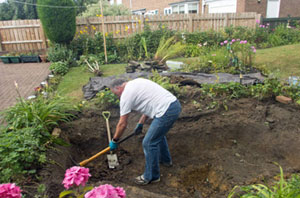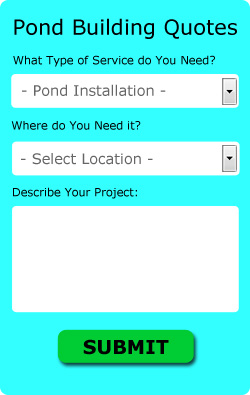Garden Pond Edging: Garden ponds, as captivating features, infuse outdoor spaces with tranquility and life. Whether they're small or large, formal or natural, all ponds benefit from considerate pond edging. The dual purpose of pond edging includes enhancing the pond's visual appeal and fulfilling vital functional roles. We venture into a comprehensive exploration, delving into the domain of garden pond edging, addressing its materials, various aspects, design considerations, and maintenance tips. Discover how the right pond edging can transform your garden into a serene oasis of beauty and harmony.
The Importance of Garden Pond Edging: Pond edging is not just a decorative element; it plays a pivotal role in maintaining the health and aesthetics of your garden pond. One of its primary functions is to contain water within the pond. Without proper edging, soil erosion can occur, causing the water level to fluctuate and potentially harming aquatic life and plants. By creating a barrier between the pond water and surrounding soil, edging helps stabilize the ecosystem.
Additionally, pond edging provides a visual boundary, defining the pond's shape and size. This delineation adds structure to the garden, making it easier to integrate the pond into the overall landscape design. It also prevents unwanted intrusion into the pond area, keeping children and pets safe.
Materials for Pond Edging: Choosing the right material for your pond edging is crucial as it influences both the aesthetic and functional aspects of your garden pond. Several materials are commonly used for pond edging, each with its unique characteristics:
-
Natural Stone: Natural stones like slate, granite, or limestone offer a rustic and organic look. They blend seamlessly with naturalistic pond designs and create a harmonious transition between the pond and the garden. These stones can be stacked or laid flat to form a durable and attractive edging.
-
Brick or Pavers: Bricks and pavers provide a classic, structured appearance. They are available in various colors and sizes, allowing for versatile design options. Brick or paver edging is particularly suitable for formal or contemporary garden pond designs.
-
Gravel or Pebbles: Gravel or pebble edging is a cost-effective and low-maintenance option. It provides a natural appearance while allowing water to drain through easily. However, it may require occasional replenishing due to displacement.
-
Timber: Wooden edging, such as railway sleepers or treated timber, adds warmth and a rustic charm to the pond area. It can be used to create raised beds or decking around the pond, making it a versatile choice for various garden styles.
-
Concrete or Masonry: Concrete or masonry blocks can be used to construct custom-designed edging. They offer durability and flexibility in shaping the pond's borders. When finished with a suitable facade, they can mimic natural stone or brick.
Design Considerations: When planning your garden pond edging, consider the following design factors to create a cohesive and visually pleasing landscape:
-
Pond Shape: The shape of your pond should dictate the style of edging. Curved ponds often benefit from natural stone or gravel edging, while angular ponds may look better with brick or concrete.
-
Garden Style: Match the edging material to the overall style of your garden. For a traditional garden, brick or timber may be ideal, while natural stone suits a more naturalistic or cottage garden.
-
Safety: Safety is paramount, especially if you have children or pets. Ensure the edging is secure and offers a clear visual barrier to the pond.
-
Accessibility: Consider accessibility for maintenance and cleaning. Plan pathways or stepping stones around the pond for easy access.
-
Plant Integration: Edging can be a habitat for aquatic plants. Choose materials that can support plant growth or create planting pockets within the edging.
-
Scale and Proportion: The size and thickness of the edging should be proportional to the pond's dimensions. Larger ponds may require thicker or more substantial edging materials.
-
Maintenance: Keep in mind the long-term maintenance requirements of your chosen edging material. Some materials may require periodic cleaning or sealing to retain their appearance.
Maintenance and Care: Proper maintenance of your pond edging ensures it continues to enhance your garden's beauty and functionality. Regularly inspect the edging for signs of damage or displacement, especially after heavy rain or freezing temperatures. Remove debris and fallen leaves to prevent blockage and maintain water circulation. If you have wooden edging, check for rot or decay and treat or replace it as needed. Periodically pressure wash or scrub non-porous materials like brick or stone to keep them looking their best. With routine care, your garden pond edging will remain an enduring and delightful feature in your outdoor space.

Our Pond Builders Pages
https://www.pondwise.uk/newbridge.html
https://www.pondwise.uk/thundersley.html
https://www.pondwise.uk/clowne.html
https://www.pondwise.uk/fairford.html
https://www.pondwise.uk/blackwater.html
https://www.pondwise.uk/treeton.html
https://www.pondwise.uk/birdwell.html
https://www.pondwise.uk/lostwithiel.html
Conclusion: Garden pond edging is a vital component of any pond design, offering both aesthetic and practical benefits. It provides structural definition, prevents erosion, and enhances the overall appeal of the pond and the surrounding landscape. By carefully selecting the right edging material and considering design elements, you can create a garden pond that not only complements your outdoor space but also thrives as a harmonious and sustainable ecosystem. Invest in your garden pond's edging, and reap the rewards of a serene and visually stunning outdoor oasis.


